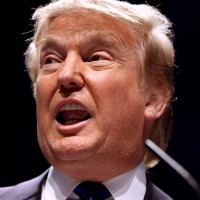
Picture: Gage Skidmore
Donald Trump is now President-elect of the Divided States of America after winning a democratic election as bitterly fought as any other in the Republic’s long history, writes Sunder Katwala.
Trump spoke softly in victory, recognising how the excitement of his supporters was matched by fear among many of their fellow Americans. The conventional ‘motherhood and apple pie’ pieties of every Presidential acceptance speech – the commitment to be a President to all Americans, and to reach out to those who had not voted for him – mattered more this time. Many will remain sceptical about any merely implicit disavowal of so many things said in the shock-jock campaign – including his prejudice targeting Mexican immigrants and Muslims, and Trump’s history of misogyny towards women.
Trump’s victory in the Electoral College gives him the right to govern. He will take office in a position of unusual strength – the first Republican President whose party control both Houses of Congress since 1928 – yet weakness too. There was no Trump landslide. Donald Trump and Hillary Clinton won just over 59 million votes each – both falling well short of the 60.9 million Americans who voted for losing candidate Mitt Romney four years ago. Five million fewer Americans cast a Presidential ballot than four years ago. Unlike Britain’s referendum on the EU, this was not a contest which saw more people return to the ballot box.
Trump has much to prove to the six out of ten Americans who believe he does not have the qualifications and temperament to be President – a significant number of whom voted for him anyway, though doubting his ability to do the job. Having never held elected office was part of Trump’s outsider appeal. In politics, the billionaire President is himself now The Apprentice, placing an unusual burden of responsibility on Vice-President Mike Pence, and making the new administration less predictable than any before it. So America’s choice will test the constitutional checks and balances of the US system.
President Obama has shown dignity and grace in his commitment to helping to smooth the transition. Having told voters that “my name is not on the ballot, but my legacy is on the ballot”, America’s first black President will surely take it as a personal repudiation that the country which twice chose him to be President has now elected a man who came to public prominence by questioning Obama’s birthplace – and even his right to be considered an American. That Obama ends his second term with a 54% approval rating in the nation which has elected Trump to succeed him highlights the curious existence of a significant number of Obama-Trump voters, who didn’t see Obama’s preferred Democratic successor as representing change that they could believe in.
Abroad, the dominant mood is of anxiety and bewilderment. Only in Russia did any nation’s public hope America would choose Trump over Clinton, which is not a thought that reassures many across Europe. German Chancellor Angela Merkel struck the balance in her message recommitting both to the importance of the Transatlantic partnership with the US – and the values which underpin it too.
It would hardly be enough, for example, for the President-elect to simply forget that the campaign proposal to ban Muslims from entering the United States was ever made: a clear statement about why it will not be pursued will be needed.
There will be much unpicking of the US result – with many outside America seeing Trump’s victory as reflecting the increasing challenge of political populism across Western democracies. There are important similarities and shared drivers – especially in how politics is increasingly polarised around the difference in worldviews between graduates and those with less formal education, which is increasingly joining class, faith and ethnicity among the key political cleavages.
It is despite – or perhaps more accurately because – our societies have never been more highly educated that education has become a prominent factor in determining political differences. This divide has also created a debate about whether politics should be about facts or emotions. The evidence that emotions matter more has been mounting up for a long time and should be heeded; but at the same time voters will also expect a politician to deliver on the promises made on the campaign stump – and this may turn out to be a significant challenge for the new President once he takes office.
But the differences in populist challenges are just as important. America is not Britain or Europe. The meaning of race in America – shaped by slavery and segregation – differs from European experiences of Empire, decolonisation and post-war immigration, which have generated rather different legacies in Britain, Belgium or France. Meanwhile, Europe’s arguments over Muslim integration reflect a considerably different demographic, social and economic picture than that in the United States, though concerns about Islamist extremist terrorism are shared.
As religious faith is much stronger in America than Europe today, the US appears to have a more profound cultural rift between rural America and the urban cosmopolitanism of the richer metropolitan centres. Deep American divides over what the constitution should say about gun control and abortion are largely missing from European politics, while debates about sovereignty and free movement in the European Union are significantly different from arguments about the UN or multilateralism in America.
Britons divided down the middle on Brexit but strongly preferred Clinton to Trump by a four-to-one margin. This suggests that that, whatever the many uncertainties about what Brexit will mean, it appeared to most Britons a considerably more plausible proposition than sending President Trump to the White House.
There may be many things we can learn by comparing experiences of populist challenges on both sides of the Atlantic – concerning how liberal counter-arguments failed to land and also why populist arguments resonated so strongly with voters. It will be necessary to learn how the use of emotional engagement in politics, which works for populism, might not only and always be decried as the problem of “post-truth politics” but become part of the solution for an emotionally intelligent way to defend liberal principles and causes. Evidence should matter in making policy, but nobody has ever fact-checked their way to political success. It is now a decade since Drew Westen, author of The Political Brain, wrote back in 2007 about the dangers for the Democrats of “an irrational emotional commitment to rationality … that renders them, ironically, impervious to both scientific evidence on how the political mind and brain work and to an accurate diagnosis of why their campaigns repeatedly fail.”
The answer to a politics of “them versus us” cannot be the rejection of identity as dangerous – nor an acceptance of an entirely polarised battle with no effort to seek common ground. Challenging prejudice effectively also needs an appeal to shared identities which can reach those who are anxious, and sometimes fearful, but not irredeemably prejudiced.
What this means – and how it is done – will be very different in Britain, in America, in France and elsewhere. The challenges in these countries are different and the responses should be too. All politics is local. Populist challenges are rooted in the specific felt experiences of particular places. Any effective responses will have to be too.






